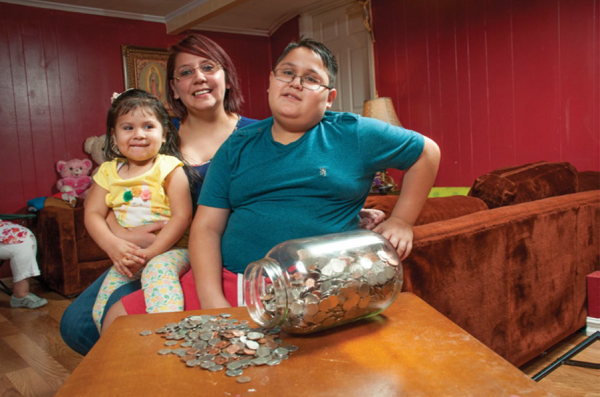
Carmen Morfin Villa had long wanted to be a homeowner by the time she had reason to be in a bank lobby last spring.
“I wanted a home for me and for my kids,” says Villa, of El Dorado, mother of 13-year-old Alex and 2-year-old Ximena. Villa had an account at another bank in town. She had inquired at that bank, and at a few others, about whether she could qualify for a loan to buy a home.
“The answer was always no because I didn’t have enough money or I didn’t have the credit,” she says. “They told me at one that if I’ve got $15,000 to get a house down payment maybe we can get something worked out but I was like, I don’t have that much money. I was like, ‘How am I going to build some credit if they don’t give me a chance to have some credit?’”
She went to Southern Bancorp to make a payment on some bedroom furniture she had bought from a local store and was greeted by Maggie Goff, a bilingual teller.
“I told her our bank is really good about helping low income people get on their feet,” says Goff, who told Villa about the bank’s Credit Builder CD.
The Credit Builder CD is a $1,000 loan Villa paid off monthly, and then she received the value of the CD, plus interest and wasleft with an improved credit rating to boot.
They had an apartment but Villa hated throwing her money into rent. She wanted to invest in her own home and start building assets for her family. Alex, too, wanted a home.“I wanted a house for me and my mom and my sister so we could each have our rooms and we could stay in our house, not like the poor people who are staying outside,” says Alex. “We started to save money to buy our own house.”
Villa was diligent about paying off her Credit Builder CD and when that was done, Goff helped her fill out a mortgage application. “Sometimes when you give people a stack of paper that kind of brings them down, but when you’re there helping them step-by-step it builds them up,” says Goff.
The process moved quickly after that. Villa found a home in her price range, but when it came time to make the down payment on their home, a miscalculation meant she were slightly short of cash. “Alex ended up giving me his money because he knows that was for a dream that we had,” she says.
“He gave me his money and we finished up making the down payment with quarters and dimes and all that. We took a big bag of coins so Ms. Maggie could make the little rolls so we could make the down payment.” Alex, then 11, says he didn’t have to think about handing over about $200 he had saved from birthdays and other special occasions. “It was for our house,” he says simply.
Goff says Southern Bancorp has just introduced a program for new homeowners, allowing them to open savings accounts that the bank will match up to $1,000, to be used for home repairs. “That kind of encourages them to build up a savings account,” she says. Southern Bancorp also offers credit counseling, financial education, free tax preparation and home buyer counseling, among other services, to help people manage or improve their financial situations.
The Central Arkansas Development Council (CADC) in Benton offers similar services, which are required for some people who qualify for the Single Parent Scholarship Fund or for federal grant-funded programs, like the Low-Income Home Energy Assistance Program (LIHEAP). Assurance 16, one provision of LIHEAP, provides energy cost assistance to low-income people who participate in workshops on energy efficiency as well as on financial education through a year-long case management process.
“It’s not just about the money,” says Tim Riley, chief operating officer of community programs and development at ARVAC, Inc., Community Action Partnership in Dardanelle, which serves nine counties. “While it does focus on energy education we also talk about the importance of making sure you pay your bills on time and different things like that.”
Gary Elrod, Conservative Service Block Grant Program Participation Specialist at the CADC, says clients who go through the Assurance 16 program learn to make a household budget or spending plan and are coached in how to determine the difference between things they need and things they want.
“They keep a daily spending diary for a month and then at the end they sit down and look through that,” he says. “We have found out that little part has really made people realize what they spend during a month’s time.”
The goal is to help people learn to build their savings. “It’s to try to help them pay the bill as well as guidance on how to make a decision about it,” Elrod says. “Some take it seriously, some just say,
‘Well, I just got my bills paid.’ But if we get one, that’s something.”
If you’d like to receive our quarterly Engage Magazine, contact us at arcf@arcf.org.
